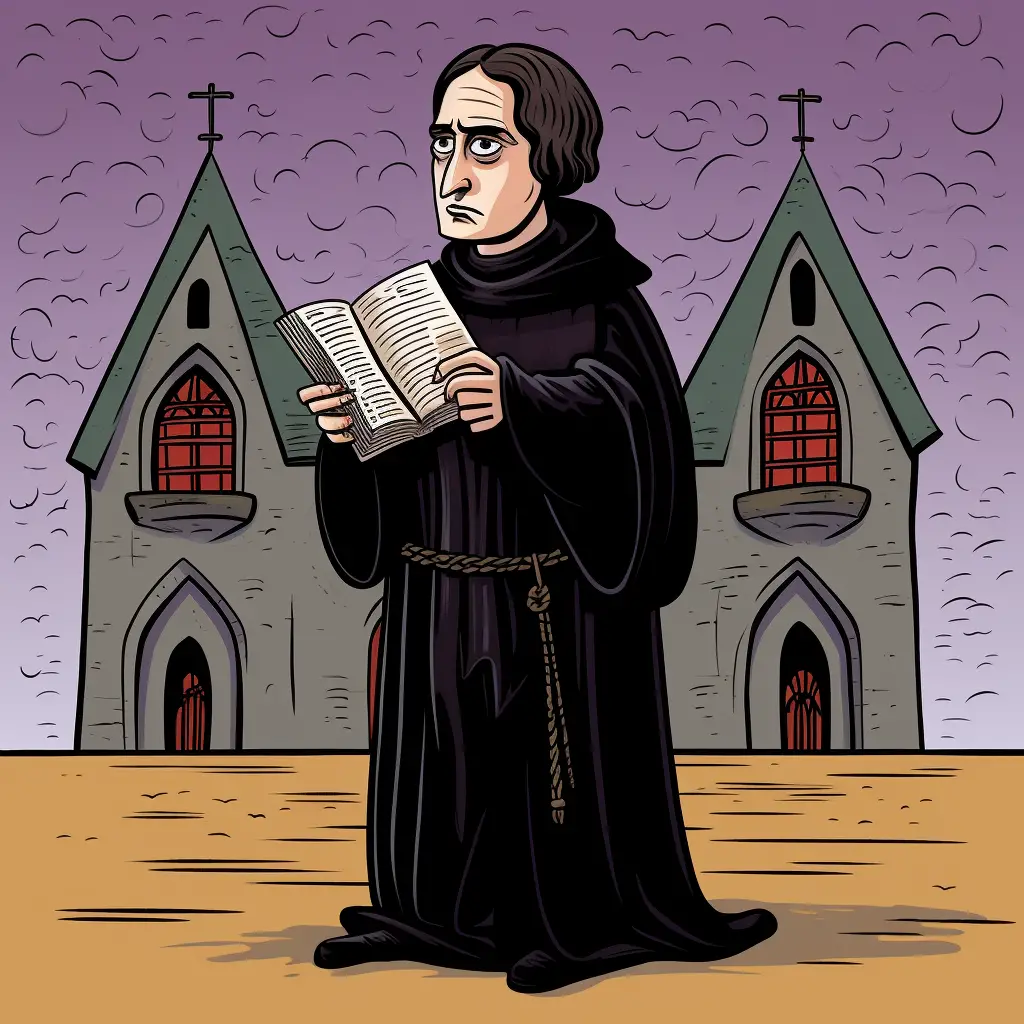Peter Abelard
Peter Abelard was a medieval philosopher and theologian known for his controversial views on love and his relationship with Heloise. He emphasized the importance of reason in theology and sought to reconcile faith and reason. Abelard’s teachings and writings had a significant impact on medieval thought and continue to be studied today. His tragic love affair with Heloise, which resulted in their separation and his castration, is also well-known and has been the subject of many literary works.

Peter Abelard Facts for Kids
- Peter Abelard was a famous philosopher in the Middle Ages.
- He was born around 1079 in Le Pallet, France.
- Abelard is best known for his love story with Héloïse.
- He taught in Paris, becoming very popular.
- Abelard wrote a book about logic, “Sic et Non”.
- He was controversial for his innovative thinking.
- Abelard also composed songs and poems.
- He was a monk and later a church official.
- His writings influenced many future philosophers.
- Abelard died in 1142 and is buried in Paris.
Scholasticism
Peter Abelard, a predominant figure in the establishment of Scholasticism, had a profound impact on the method of learning that was prevalent in European schools during the Middle Ages.
His methodology, which underscored meticulous dialectical reasoning, was aimed at resolving seeming contradictions within religious and philosophical texts. Abelard’s teachings, particularly his strong emphasis on the integration of logic within theology, were instrumental in shaping the Scholastic tradition.
His most notable work, ‘Sic et Non’ (Yes and No), urged students to seek reconciliation between opposing statements from the Church Fathers, setting the foundation for the Scholastic approach of inquiry and debate that would substantially shape future intellectual discourse.
Heloise d’Argenteuil
The twelfth century bore witness to the compelling love story of prominent philosopher and theologian, Peter Abelard, and his student, Heloise d’Argenteuil. Abelard, a bright and ambitious scholar renowned for his philosophical musings, was appointed as the tutor of Heloise, sparking an intense intellectual and romantic bond that surpassed the conventional teacher-student dynamics.
Despite the scandal that this relationship brought upon Abelard, threatening his career and reputation, their love was undeterred. Their story immortalized through a series of deeply emotional letters exchanged between them, has come to symbolize a profound demonstration of romantic and intellectual commitment.
Abelard’s philosophical teachings were profoundly shaped by his relationship with Heloise, underpinning the enduring influence of their romantic saga on his intellectual pursuits.
Medieval Philosophy
Peter Abelard, an influential figure in medieval philosophy, rose to prominence in the 12th century for his groundbreaking dialectical methodology that paved the way for scholasticism. His philosophy was anchored in strict logic and reasoning, underpinning his unique theories in ethics, theology, and metaphysics.
His seminal work, ‘Sic et Non,’ offered a collection of philosophical and theological paradoxes that questioned the traditional religious beliefs of his era, steering intellectual discussion toward a more discerning and analytical examination of philosophical and theological matters.
Abelard’s contribution to medieval philosophy is marked by his introduction of a more methodical, logical framework to philosophical debates and his emphasis on intellectual independence and reason-driven investigation. His work substantially enriched the philosophical discourse during the Middle Ages and continues to exert influence on present-day philosophical thought.
Nominalism
Celebrated medieval philosopher and theologian, Peter Abelard, is renowned for his significant contributions to the philosophical theory Nominalism. Nominalism argues that universals or general ideas are simply names without any corresponding reality, a concept that Abelard extensively developed and propagated.
He asserted that universals are merely words, or ‘nomina’, and that individual substances are the only reality. Abelard’s stance posed a critical challenge to the prevalent Realist perspective, which purports that universals exist independently of human cognition.
His seminal contributions to Nominalism signified a pivotal shift in Western philosophy, underscoring the importance of language and logic in comprehending reality.
University of Paris in the Middle Ages

The University of Paris emerged as a significant hub of intellectual activity in the Middle Ages, largely under the influence of Peter Abelard, a celebrated philosopher and theologian of the time.
Abelard’s pedagogical innovation, which promoted active questioning and discussion over passive absorption, drew learners from all corners of Europe and solidified the University’s reputation as a premier institution of knowledge. Nonetheless, his groundbreaking ideas frequently conflicted with the established Church and University doctrines, causing several disputes and ultimately leading to his expulsion.
Regardless of his stormy affiliation with the University, Abelard’s seminal contributions to the spheres of philosophy, theology, and education are still acknowledged as vital to the University of Paris’s intellectual evolution during the Medieval period.
Thomas Aquinas
The twelfth-century French philosopher and theologian, Peter Abelard, laid the foundation for later thinkers like Thomas Aquinas through his pioneering work in philosophical inquiry. Abelard’s innovative method, Sic et Non (Yes and No), entailed a systematic comparison of contrasting viewpoints, and this approach set the stage for the emergence of Scholasticism in the thirteenth century.
As a leading proponent of Scholasticism, Aquinas built upon Abelard’s method by integrating it into a wide-ranging fusion of Christian theology and Aristotelian philosophy.
Abelard’s dialectical reasoning, therefore, became an integral part of Aquinas’s intellectual framework and manifested the lasting influence of Abelard’s contributions to the fields of medieval philosophy and theology.
Ethics of Peter Abelard
Peter Abelard, an esteemed philosopher, theologian, and logician of the 12th century, made remarkable strides in the field of ethics, specifically moral philosophy. His approach was groundbreaking during his era, as he prioritized the person’s intent behind an action over the action itself.
Abelard’s argument was that moral quality isn’t inherent in an act but is dictated by the intent behind it. His emphasis on intent, which was a revolutionary concept at the time, laid the groundwork for what is now referred to as intention ethics.
His theories offered a fresh outlook on moral responsibility by endorsing the significance of personal intent and the subjective nature of morality. Thus, Abelard played a pivotal role in establishing the basis for future ethical theories.
Philosophy of Language in the Middle Ages
Peter Abelard, esteemed for his contributions to medieval philosophy and scholasticism, significantly advanced the Middle Ages’ Philosophy of Language with his groundbreaking theory of universals.
Contrary to the dominant Platonic and Aristotelian views of the time, Abelard posited that universals exist not as independent realities but as conceptual entities within our minds. This innovative perspective, often referred to as ‘nominalism’, underscored the importance of linguistic signs and human cognition in shaping reality, thereby enhancing the philosophy of language.
Abelard’s belief in the centrality of language in comprehending and interpreting the world marked a radical departure from conventional thinking, laying the groundwork for contemporary linguistic philosophy. His work remains a profound testament to the complex relationship between language and thought in philosophical discourse.
Monastic Schools
Prominent twelfth-century scholar, Peter Abelard, significantly influenced the evolution of monastic schools into advanced learning centers through his intellectual rigor and application of the dialectic method.
Choosing to teach at institutions like the Abbey of St. Denis, Abelard encouraged monks to transcend mere text memorization, advocating for critical thinking and logical reasoning instead. His innovative approach, although controversial and met with substantial opposition, reshaped traditional monastic education and laid the foundation for the emergence of universities during the Middle Ages.
Thus, Abelard’s profound impact on monastic schools signified a pivotal moment in the history of Western education.
Anselm of Canterbury
Peter Abelard, a renowned French philosopher, and theologian of the medieval era, took significant inspiration from Anselm of Canterbury’s philosophical works. Abelard’s ethical and theological doctrines were notably crafted on the bedrock of Anselm’s philosophical principles.
Anselm’s ontological argument for God’s existence formed a basis for Abelard’s more advanced focus on the nature and attributes of God. Despite their philosophical differences, both scholars were united in their commitment to rationalizing faith.
Abelard’s contentious theological approach was frequently subjected to criticism, but his intellectual tenacity and devotion were on par with Anselm’s, thereby positioning them as two of the most influential minds of the Middle Ages.
Early Life
Peter was originally called ‘Pierre le Pallet’. He was born in 1079, in le Pallet, a town near Nantes, Brittany. Peter belonged to a minor noble family. His father, Berengar was a knight. He encouraged Peter to pursue his scholarly leanings.
Peter decided to give up a career in the military and his inheritance to become an academic. He was particularly interested in liberal arts and did extremely well in dialectics (a branch of philosophy). Peter wandered throughout France to learn and seek knowledge. He first studied in Loire under the tutelage of Roscellinus of Compiegne, a famous French theologian, and philosopher who is considered the founder of nominalism. In 1100, Peter reached Paris and started studying in the cathedral school of Notre Dame de Paris under the guidance of William of Champeaux.
According to his own account, Peter had several heated arguments with William and Roscellinus during his stay with both of them. Peter thought that his ability to beat his masters in argument was the reason behind their contempt for him. William however; considered Peter to be arrogant. Peter established his own school in Corbeil near Paris.
He gained fame and respect for his teaching and a few years later he again challenged William over his theory of universals and soundly defeated him every time. William however; made sure that Peter could not teach in Paris and moved to Mulen. In 1110 he again moved to Paris. Peter then got more interested in theology and shifted to Laon where he attended lectures of Anselm. Here again, Peter had a conflict with Anselm and returned to Paris. In 1115, he became Master of Notre Dame. During his stay in Notre Dame, Peter began a torrid affair with French nun and writer Heloise d’Argenteuil, niece of secular canon Fulbert.
Their affair saw them getting married secretly and severe opposition from Fulbert. Peter sent Heloise to a convent in Argenteuil to save her from her uncle and later became a monk himself in the monastery of St Denis. At St Denis, he continued to study theology and religious texts and was critical of the way of life of other monks. In the early 1130s, Peter and Heloise composed a collection of their love letters which became very popular.
Later in his life, Peter faced the biggest crisis of his life when William of St Thiery, another French theologian accused him of heresy in his writings. As a result, Peter fell from favor with the church and papacy. He thereafter stopped teaching and writing and spent his last days at the Priory of St Marcel near Chalon-sur-Saone.
Work
Peter Abelard’s prominent pieces of philosophical work are Logica Ingredientibus (Logic for Beginners), Dialectica (Dialectics), Sic et Non (Yes or No), Tractatus de Intellectibus (A Treatise of Understanding), and Ethica or Scito Te Ipsum (Ethics or Know Yourself).
Abelard’s autobiographical work in Latin called Historia Calamitum (A History of My Troubles) also became very popular. It also carried the love letters exchanged between Peter and Heloise d’Argenteuil.
Later Life
Peter Abelard spent the last few months of his life in St Marcel, where he died on April 21, 1142. He was suffering from a fever and skin disorder.
Peter was initially buried in St Marcel but soon his remains were taken to Paraclete and given to Heloise, the love of his life. Heloise herself was buried next to Peter when she died in 1163.



